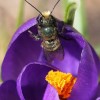 The blue orchard bee, Osmia lignaria Say (Fig. 1), is a solitary mason bee native to the west coast of the United States and Canada. It is of great interest for use as a native pollinator of fruit trees and blueberries, and is easily managed due to its favorable biological characteristics. Blue orchard bees can be purchased online for pollination, and they are shipped as pupae ready to emerge in the spring. This 4-page fact sheet was written by Alden Estep, Catherine Zettel-Nalen, and James Ellis, and published by the UF Department of Entomology and Nematology, March 2013.
The blue orchard bee, Osmia lignaria Say (Fig. 1), is a solitary mason bee native to the west coast of the United States and Canada. It is of great interest for use as a native pollinator of fruit trees and blueberries, and is easily managed due to its favorable biological characteristics. Blue orchard bees can be purchased online for pollination, and they are shipped as pupae ready to emerge in the spring. This 4-page fact sheet was written by Alden Estep, Catherine Zettel-Nalen, and James Ellis, and published by the UF Department of Entomology and Nematology, March 2013.
http://edis.ifas.ufl.edu/in982
Tag: Featured Creatures collection
Tropical Soda Apple Leaf Beetle, Gratiana boliviana Spaeth (Insecta: Coleoptera: Chrysomelidae: Cassidinae) (EENY543/IN974)
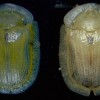 Tropical soda apple is a prickly shrub native to South America that is a major problem in pastures and conservation areas. So a multi-agency program supported the rearing, distribution, and release of more than 250,000 tropical soda apple leaf beetles across Florida from 2003 to 2011. This 4-page fact sheet was written by Rodrigo Diaz, William A. Overholt, Ken Hibbard, and Julio Medal, and published by the UF Department of Entomology and Nematology, January 2013.
Tropical soda apple is a prickly shrub native to South America that is a major problem in pastures and conservation areas. So a multi-agency program supported the rearing, distribution, and release of more than 250,000 tropical soda apple leaf beetles across Florida from 2003 to 2011. This 4-page fact sheet was written by Rodrigo Diaz, William A. Overholt, Ken Hibbard, and Julio Medal, and published by the UF Department of Entomology and Nematology, January 2013.
http://edis.ifas.ufl.edu/in974
Air Potato Leaf Beetle (Suggested Common Name), Lilioceris cheni Gressitt and Kimoto (Insecta: Coleoptera: Chrysomelidae: Criocerinae) (EENY547/IN972)
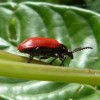 This leaf feeding beetle was recently introduced into Florida from China for biological control of air potato. This 4-page fact sheet provides information on the distribution, appearance, life cycle, host range and importance of the beetle. Written by Entomology and Nematology, and published by the UF Department of Ted D. Center and William A. Overholt, January 2013.
This leaf feeding beetle was recently introduced into Florida from China for biological control of air potato. This 4-page fact sheet provides information on the distribution, appearance, life cycle, host range and importance of the beetle. Written by Entomology and Nematology, and published by the UF Department of Ted D. Center and William A. Overholt, January 2013.
http://edis.ifas.ufl.edu/in972
Puss Caterpillar (Larva), Southern Flannel Moth (Adult), Megalopyge opercularis (J. E. Smith 1797) (Insecta: Lepidoptera: Zygaenoidea: Megalopygidae) (EENY545/IN976)
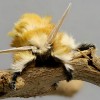 The southern flannel moth is an attractive small moth that is best-known because of its larva, the puss caterpillar, which is one of the most venomous caterpillars in the United States. This 12-page fact sheet was written by Donald W. Hall, and published by the UF Department of Entomology and Nematology, January 2013.
The southern flannel moth is an attractive small moth that is best-known because of its larva, the puss caterpillar, which is one of the most venomous caterpillars in the United States. This 12-page fact sheet was written by Donald W. Hall, and published by the UF Department of Entomology and Nematology, January 2013.
http://edis.ifas.ufl.edu/in976
Amaryllis Lesion Nematode, Pratylenchus hippeastri Inserra et al., 2006 (Nematoda: Tylenchida: Pratylenchidae) (EENY546/IN975)
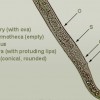 Amaryllis lesion nematode is an important nematode pest of amaryllis in Florida. It reduces plant vigor, flower yield, and bulb size. As the nematodes tunnel through the root, the damaged cells die and collapse, forming lesions on the exterior and the interior of the root tissue. This 4-page fact sheet was written by William T. Crow, and published by the UF Department of Entomology and Nematology, January 2013.
Amaryllis lesion nematode is an important nematode pest of amaryllis in Florida. It reduces plant vigor, flower yield, and bulb size. As the nematodes tunnel through the root, the damaged cells die and collapse, forming lesions on the exterior and the interior of the root tissue. This 4-page fact sheet was written by William T. Crow, and published by the UF Department of Entomology and Nematology, January 2013.
http://edis.ifas.ufl.edu/in975
A mosquito Psorophora ciliata (Fabricius) (Insecta: Diptera: Culicidae) (EENY540/IN967)
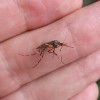 Psorophora ciliata (Fabricius) is a large mosquito that has developed an outsized reputation because of its relatively intimidating heft and persistent biting behavior, including anecdotal historical accounts of its legendary aggressiveness and ‘frightening appearance’. This 6-page fact sheet was written by Ephraim V. Ragasa and Phillip E. Kaufman, and published by the UF Department of Entomology and Nematology, October 2012.
Psorophora ciliata (Fabricius) is a large mosquito that has developed an outsized reputation because of its relatively intimidating heft and persistent biting behavior, including anecdotal historical accounts of its legendary aggressiveness and ‘frightening appearance’. This 6-page fact sheet was written by Ephraim V. Ragasa and Phillip E. Kaufman, and published by the UF Department of Entomology and Nematology, October 2012.
http://edis.ifas.ufl.edu/in967
A Colonial tentweb orbweaver Cyrtophora citricola (EENY535/IN966)
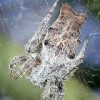 Few species of spiders can be considered truly social, but a greater number of species, particularly web-building spiders, live in close proximity to one another. One species which has become highly successful through a lifestyle of colonial aggregation is the orbweaver Cyrtophora citricola Forskål. This 6-page fact sheet was written by Lionel A. Stange, and published by the UF Department of Entomology and Nematology, October 2012.
Few species of spiders can be considered truly social, but a greater number of species, particularly web-building spiders, live in close proximity to one another. One species which has become highly successful through a lifestyle of colonial aggregation is the orbweaver Cyrtophora citricola Forskål. This 6-page fact sheet was written by Lionel A. Stange, and published by the UF Department of Entomology and Nematology, October 2012.
http://edis.ifas.ufl.edu/in966
Green lacewings (of Florida) Neuroptera: Chrysopidae (EENY534/IN965)
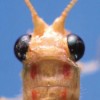 The Chrysopidae are one of the largest and economically most important families of the Neuroptera. There are about 1,300 currently recognized species included in about 87 genera and three subfamilies (Brooks and Bernard 1990) in the world. In Florida, there are 22 species in 9 genera, all placed in the subfamily Chrysopinae (Penny et al. 1997). The larvae are voracious predators of small, comparatively soft-bodied arthropods such as aphids, scale insects, whiteflies, thrips, insect eggs, and other prey (Muma 1959; Canard et al. 1984). For this reason they are used widely in biological control. The adults are usually predators, but a few species only feed on pollen. This 4-page fact sheet includes Key to the Genera of Green Lacewings of Florida. Written by Lionel A. Stange, and published by the UF Department of Entomology and Nematology, November 2012.
The Chrysopidae are one of the largest and economically most important families of the Neuroptera. There are about 1,300 currently recognized species included in about 87 genera and three subfamilies (Brooks and Bernard 1990) in the world. In Florida, there are 22 species in 9 genera, all placed in the subfamily Chrysopinae (Penny et al. 1997). The larvae are voracious predators of small, comparatively soft-bodied arthropods such as aphids, scale insects, whiteflies, thrips, insect eggs, and other prey (Muma 1959; Canard et al. 1984). For this reason they are used widely in biological control. The adults are usually predators, but a few species only feed on pollen. This 4-page fact sheet includes Key to the Genera of Green Lacewings of Florida. Written by Lionel A. Stange, and published by the UF Department of Entomology and Nematology, November 2012.
http://edis.ifas.ufl.edu/in965
Burrowing Nematode Radopholus similis (Cobb, 1893) Thorne, 1949 (Nematoda: Secernentea: Tylenchida: Pratylenchidae: Pratylenchinae) (EENY542/IN969)
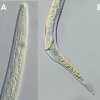 The burrowing nematode is the most economically important nematode parasite of banana in the world. Infection causes toppling disease of banana, yellows disease of pepper and spreading decline of citrus. These diseases are the result of burrowing nematode infection destroying root tissue, leaving plants with little to no support or ability to take up water and translocate nutrients. Because of the damage that it causes to citrus, ornamentals and other agricultural industries, worldwide, burrowing nematode is one of the most regulated nematode plant pests. This 5-page fact sheet was written by Nicholas Sekora and William T. Crow, and published by the UF Department of Entomology and Nematology, November 2012.
The burrowing nematode is the most economically important nematode parasite of banana in the world. Infection causes toppling disease of banana, yellows disease of pepper and spreading decline of citrus. These diseases are the result of burrowing nematode infection destroying root tissue, leaving plants with little to no support or ability to take up water and translocate nutrients. Because of the damage that it causes to citrus, ornamentals and other agricultural industries, worldwide, burrowing nematode is one of the most regulated nematode plant pests. This 5-page fact sheet was written by Nicholas Sekora and William T. Crow, and published by the UF Department of Entomology and Nematology, November 2012.
http://edis.ifas.ufl.edu/in969
Tropical sod webworm Herpetogramma phaeopteralis Guenee (Insecta: Lepidoptera: Crambidae) (EENY541/IN968)
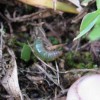 Tropical sod webworm larvae are destructive pests of warm season turfgrasses in the southeastern U.S., especially on newly established sod, lawns, athletic fields, and golf courses. Larval feeding damage reduces turfgrass aesthetics, vigor, photosynthesis and density. The first sign of damage is often caused by differences in grass height in areas where larvae are feeding. This 5-page fact sheet was written by Nastaran Tofangsazie, Steven P. Arthurs, and Ronald Cherry, and published by the UF Department of Entomology and Nematology, November 2012.
Tropical sod webworm larvae are destructive pests of warm season turfgrasses in the southeastern U.S., especially on newly established sod, lawns, athletic fields, and golf courses. Larval feeding damage reduces turfgrass aesthetics, vigor, photosynthesis and density. The first sign of damage is often caused by differences in grass height in areas where larvae are feeding. This 5-page fact sheet was written by Nastaran Tofangsazie, Steven P. Arthurs, and Ronald Cherry, and published by the UF Department of Entomology and Nematology, November 2012.
http://edis.ifas.ufl.edu/in968
Tobacco Budworm, Heliothis virescens (Fabricius) (Insecta: Lepidoptera: Noctuidae) (EENY219/IN376)
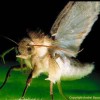 The tobacco budworm, Heliothis virescens (Fabricius), is a native species and is found throughout the eastern and southwestern United States. It is principally a field crop pest, attacking such crops as alfalfa, clover, cotton, flax, soybean, and tobacco. Larvae bore into buds and blossoms (the basis for the common name of this insect), and sometimes the tender terminal foliar growth, leaf petioles, and stalks. This 6-page fact sheet was written by J. L. Capinera, and published by the UF Department of Entomology and Nematology, October 2012.
The tobacco budworm, Heliothis virescens (Fabricius), is a native species and is found throughout the eastern and southwestern United States. It is principally a field crop pest, attacking such crops as alfalfa, clover, cotton, flax, soybean, and tobacco. Larvae bore into buds and blossoms (the basis for the common name of this insect), and sometimes the tender terminal foliar growth, leaf petioles, and stalks. This 6-page fact sheet was written by J. L. Capinera, and published by the UF Department of Entomology and Nematology, October 2012.
http://edis.ifas.ufl.edu/in376
Alligatorweed flea beetle Agasicles hygrophila Selman and Vogt (Coleoptera: Chrysomelidae: Halticinae) (EENY462/IN831)
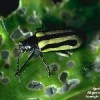 Alligatorweed is an aquatic weed native to South America that began threatening Florida’s waterways in the early 1900s. Alligatorweed flea beetles kill the plant by destroying its stored food and interfering with photosynthesis by removing leaf tissue. This insect has been an extremely effective biological control agent in coastal regions of the southeastern United States. This 3-page fact sheet was written by Ted D. Center, James P. Cuda, Michael J. Grodowitz, and published by the UF Department of Entomology and Nematology, October 2012.
Alligatorweed is an aquatic weed native to South America that began threatening Florida’s waterways in the early 1900s. Alligatorweed flea beetles kill the plant by destroying its stored food and interfering with photosynthesis by removing leaf tissue. This insect has been an extremely effective biological control agent in coastal regions of the southeastern United States. This 3-page fact sheet was written by Ted D. Center, James P. Cuda, Michael J. Grodowitz, and published by the UF Department of Entomology and Nematology, October 2012.
http://edis.ifas.ufl.edu/in831
Pepper Fruit Fly Atherigona orientalis (Schiner) (Insecta: Diptera: Muscidae) (EENY539/IN948)
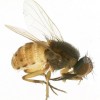 Although it is commonly referred to as the pepper fruit fly or tomato fruit fly, Atherigona orientalis is not a true fruit fly in the family Tephritidae, but rather a member of the Muscidae, the same family to which the common house fly belongs. It is found in most tropical and subtropical areas of the world and is usually considered a secondary pest or “trash fly.” But it can sometimes be a primary pest of certain agricultural crops, most notably plants in the family Solanaceae. This 4-page fact sheet was written by Kenneth L. Hibbard and William A. Overholt, and published by the UF Department of Entomology and Nematology, September 2012.
Although it is commonly referred to as the pepper fruit fly or tomato fruit fly, Atherigona orientalis is not a true fruit fly in the family Tephritidae, but rather a member of the Muscidae, the same family to which the common house fly belongs. It is found in most tropical and subtropical areas of the world and is usually considered a secondary pest or “trash fly.” But it can sometimes be a primary pest of certain agricultural crops, most notably plants in the family Solanaceae. This 4-page fact sheet was written by Kenneth L. Hibbard and William A. Overholt, and published by the UF Department of Entomology and Nematology, September 2012.
http://edis.ifas.ufl.edu/in948
Black-tailed Mosquito Culiseta melanura (Coquillett) (Insecta: Diptera: Culicidae) (EENY536/IN950)
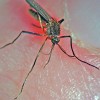 The black-tailed mosquito is unusual because it overwinters as larvae while most mosquito species overwinter as either adults or eggs. Culiseta melanura is important because of its role in the transmission cycle of eastern equine encephalitis virus and potentially West Nile virus: because adult female Culiseta melanura primarily take their blood meals from birds, they are responsible for transmitting eastern equine encephalitis virus between birds. This 6-page fact sheet was written by Eva Buckner, Angelique Showman, and C. Roxanne Connelly, and published by the UF Department of Entomology and Nematology, September 2012.
The black-tailed mosquito is unusual because it overwinters as larvae while most mosquito species overwinter as either adults or eggs. Culiseta melanura is important because of its role in the transmission cycle of eastern equine encephalitis virus and potentially West Nile virus: because adult female Culiseta melanura primarily take their blood meals from birds, they are responsible for transmitting eastern equine encephalitis virus between birds. This 6-page fact sheet was written by Eva Buckner, Angelique Showman, and C. Roxanne Connelly, and published by the UF Department of Entomology and Nematology, September 2012.
http://edis.ifas.ufl.edu/in950
Florida Scorpionfly, Panorpa floridana Byers (Insecta: Mecoptera: Panorpidae) (EENY538/IN949)
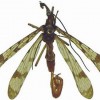 Have you seen this insect? No living individuals of Panorpa floridana ever have been observed. Knowledge of this species of scorpionfly is limited to five specimens from Alachua and Clay counties in northern peninsular Florida, the last one collected in 1982. This 4-page fact sheet was written by Louis A. Somma and James C. Dunford, and published by the UF Department of Entomology and Nematology, September 2012.
Have you seen this insect? No living individuals of Panorpa floridana ever have been observed. Knowledge of this species of scorpionfly is limited to five specimens from Alachua and Clay counties in northern peninsular Florida, the last one collected in 1982. This 4-page fact sheet was written by Louis A. Somma and James C. Dunford, and published by the UF Department of Entomology and Nematology, September 2012.
http://edis.ifas.ufl.edu/in949
Cactus Moth, Cactoblastis cactorum (Berg) (Insecta: Lepidoptera: Pyralidae) (EENY056/IN213)
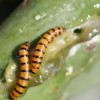 Since its arrival in the Florida Keys in 1989, this invasive species has become a serious threat to the diversity and abundance of Opuntia cactus in North America. The spread of this moth raises concerns about harm to rare opuntioid species (prickly pear and related cacti), the endangerment of wild opuntioids in the southwestern United States and Mexico and the consequent effects on entire desert ecosystems and economic hardship for communities in Mexico that cultivate and sell Opuntia. This 5-page fact sheet was written by D. H. Habeck, F. D. Bennett, and Christine Miller, and published by the UF Department of Entomology and Nematology, September 2012.
Since its arrival in the Florida Keys in 1989, this invasive species has become a serious threat to the diversity and abundance of Opuntia cactus in North America. The spread of this moth raises concerns about harm to rare opuntioid species (prickly pear and related cacti), the endangerment of wild opuntioids in the southwestern United States and Mexico and the consequent effects on entire desert ecosystems and economic hardship for communities in Mexico that cultivate and sell Opuntia. This 5-page fact sheet was written by D. H. Habeck, F. D. Bennett, and Christine Miller, and published by the UF Department of Entomology and Nematology, September 2012.
http://edis.ifas.ufl.edu/in213
Earthworm, suborder Crassiclitellata, cohort Terrimegadrili (Jamieson, 1988) (EENY532/IN946)
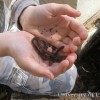 Like insects, earthworms are among the animals most frequently encountered by many Floridians. Our kids play with them, dissect them in middle school biology, we fish with them, they crawl across our sidewalks and live in our flower pots. Despite this, their ecological and economic importance often goes unrecognized. Earthworms have several important ecological roles. Additionally, some species are used commercially for bait, animal feed, environmental remediation, and composting. This 6-page fact sheet was written by William T. Crow, and published by the UF Department of Entomology and Nematology, September 2012.
Like insects, earthworms are among the animals most frequently encountered by many Floridians. Our kids play with them, dissect them in middle school biology, we fish with them, they crawl across our sidewalks and live in our flower pots. Despite this, their ecological and economic importance often goes unrecognized. Earthworms have several important ecological roles. Additionally, some species are used commercially for bait, animal feed, environmental remediation, and composting. This 6-page fact sheet was written by William T. Crow, and published by the UF Department of Entomology and Nematology, September 2012.
http://edis.ifas.ufl.edu/in946
An Asian Ground Beetle, Mochtherus tetraspilotus (MacLeay) (Coleoptera: Carabidae: Lebiini) (EENY533/IN951)
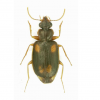 Mochtherus tetraspilotus (MacLeay) was first detected in southern Florida in 1992. Since then specimens have been collected in Gainesville and at Archbold Biological Station in Highlands County. Adult members of this group of Carabidae are known to be predators. The impact of this species on our native species remains to be determined, as does the source of introduction. Its rapid spread in Florida suggests that it may soon be found throughout the Gulf States. This 2-page fact sheet was written by Paul M. Choate, and published by the UF Department of Entomology and Nematology, September 2012.
Mochtherus tetraspilotus (MacLeay) was first detected in southern Florida in 1992. Since then specimens have been collected in Gainesville and at Archbold Biological Station in Highlands County. Adult members of this group of Carabidae are known to be predators. The impact of this species on our native species remains to be determined, as does the source of introduction. Its rapid spread in Florida suggests that it may soon be found throughout the Gulf States. This 2-page fact sheet was written by Paul M. Choate, and published by the UF Department of Entomology and Nematology, September 2012.
http://edis.ifas.ufl.edu/in951
Citrus Mealybug Planococcus citri (Risso) (Insecta: Hemiptera: Pseudococcidae) (EENY537/IN947)
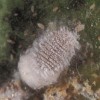 The citrus mealybug is a common pest of citrus primarily in greenhouses, and of several ornamental plants in Florida. It has been recognized as a difficult to control pest in Europe since 1813, where it is called the greenhouse mealybug and in the United States since 1879. This 4-page fact sheet was written by Harsimran Kaur Gill, Gaurav Goyal, and Jennifer Gillett-Kaufman, and published by the UF Department of Entomology and Nematology, September 2012.
The citrus mealybug is a common pest of citrus primarily in greenhouses, and of several ornamental plants in Florida. It has been recognized as a difficult to control pest in Europe since 1813, where it is called the greenhouse mealybug and in the United States since 1879. This 4-page fact sheet was written by Harsimran Kaur Gill, Gaurav Goyal, and Jennifer Gillett-Kaufman, and published by the UF Department of Entomology and Nematology, September 2012.
http://edis.ifas.ufl.edu/in947
Entomopathogenic Nematodes (Nematoda: Rhabditida: families Steinernematidae and Heterorhabditidae) (EENY530/IN944)
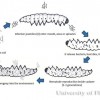 Entomopathogenic nematodes are soft bodied, non-segmented roundworms that are obligate or sometimes facultative parasites of insects. They occur naturally in soil environments and locate their host in response to carbon dioxide, vibration, and other chemical cues. They fit nicely into integrated pest management programs because they are nontoxic to humans, specific to their target pests, and can be applied with standard pesticide equipment. This 4-page fact sheet was written by Nastaran Tofangsazie, Steven P. Arthurs, and Robin M. Giblin-Davis, and published by the UF Department of Entomology and Nematology, August 2012.
Entomopathogenic nematodes are soft bodied, non-segmented roundworms that are obligate or sometimes facultative parasites of insects. They occur naturally in soil environments and locate their host in response to carbon dioxide, vibration, and other chemical cues. They fit nicely into integrated pest management programs because they are nontoxic to humans, specific to their target pests, and can be applied with standard pesticide equipment. This 4-page fact sheet was written by Nastaran Tofangsazie, Steven P. Arthurs, and Robin M. Giblin-Davis, and published by the UF Department of Entomology and Nematology, August 2012.
http://edis.ifas.ufl.edu/in944